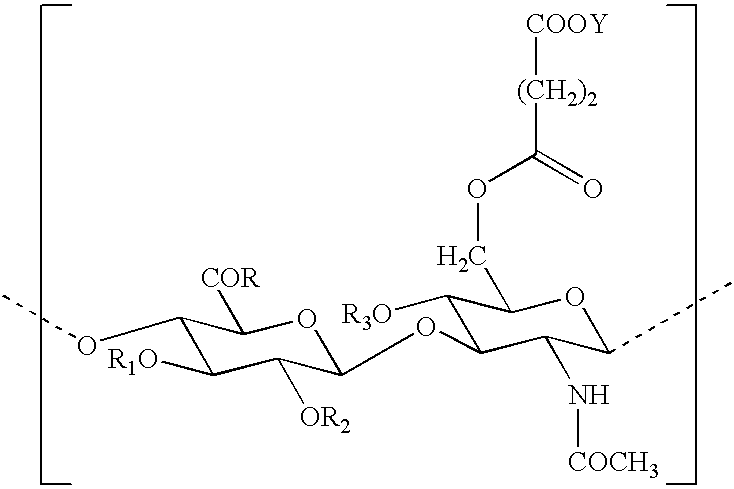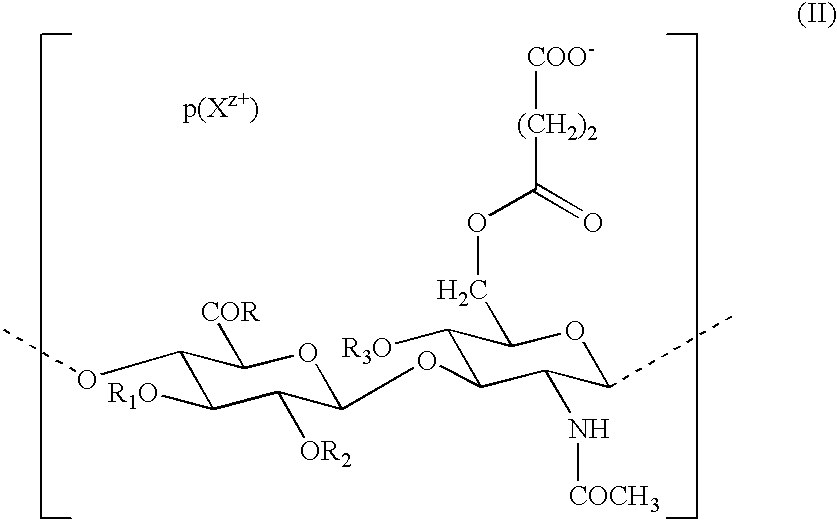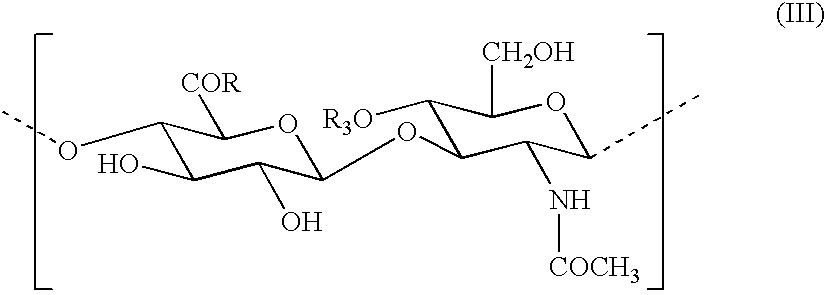Use of hyaluronic acid derivatives in the preparation of biomaterials with a physical haemostatic and plugging activity and a preventive activity in the formation of adhesions following anastomosis
a technology of hyaluronic acid and derivatives, which is applied in the field of polysaccharide derivatives, can solve the problems of intravascular thrombosis and seepage of blood between stitches, and achieve the effect of preventing scar tissue formation
- Summary
- Abstract
- Description
- Claims
- Application Information
AI Technical Summary
Benefits of technology
Problems solved by technology
Method used
Image
Examples
example 2
[0056] A solution of sodium hyaluronate (HA-Na, 1 g, MW 30,000) in distilled water (35 ml) and N,N-dimethylformamide (DMF, 100 ml) was stirred in the presence of ion exchange resin (3 g, IR 120 H+) for 10 minutes and then the resin was removed by filtration after further dilution with DMF (100 ml). The solution was then neutralized with an excess of pyridine (10 ml) to give the pyridine salt of hyaluronic acid (HA-Py). The viscous solution was then carefully evaporated in a vacuum to remove the water present, without allowing the total volume of the solution to drop below about 100 ml. This water-removing procedure was repeated three times, each time with the addition of DMF (20 ml). The solution was then treated with succinic anhydride (3 g) and pyridine (10 ml) while being stirred at 70.degree. C. for 24 hours. The reaction mixture was then concentrated, gathered with distilled water (20 ml), dialyzed against distilled water (3 times 750 ml) and freeze-dried to give hyaluronic aci...
example 3
[0058] A solution of sodium hyaluronate (HA-Na, 0.5 g, MW 160,000) in distilled water (35 ml) and N,N-dimethylformamide (DMF 100 ml) was stirred in the presence of ion exchange resin (3 G, IR 120 H+) for 10 minutes and then the resin was removed by filtration after further dilution with DMF (75 ml). The solution was then neutralized with an excess of pyridine (6 ml) to give the pyridine salt of hyaluronic acid (Ha-Py), the viscous solution was then carefully evaporated in a vacuum to remove the water present, without allowing the total volume of the solution to drop below about 50 ml. This water-removing procedure was repeated three times, each time with the addition of DMF (10 ml). The solution was then treated with succinic anhydride (2 g), 4-dimethylaminopyridine (10 mg) and pyridine (10 ml), while stirring at 70.degree. C. for 48 hours. Further quantities of succinic anhydride were added (1 g) and pyridine (2.5 ml) and the mixture was stirred for another 24 hours. The reaction m...
example 4
[0059] A solution of sodium hyaluronate (HA-Na, 0.5 G, MW 240,000) in distilled water (60 ml) and N,N-dimethylformamide (DMF 60 ml) was stirred in the presence of ion exchange resin (1 G. IR 120 H+) for 10 minutes, after which the resin was removed by filtration after further dilution with DMF (50 ml). The solution was then neutralized with an excess of pyridine (6 L) to give the pyridine salt of hyaluronic acid (HA-Py). The viscous solution was then carefully evaporated in a vacuum to remove the water present, without allowing the total volume of the solution to drop below about 100 ml. This water-removing procedure was repeated three times, each time with the addition of DMF (20 ml). The gelatin-like solution was then treated with succinic anhydride (2 g) and pyridine (5 ml) at 70.degree. C., while being stirred for 18 hours. Further quantities of succinic anhydride (2.5 g) and 4-dimethylaminopyridine (200 mg) were added and the mixture was stirred for another 24 hours. The reacti...
PUM
| Property | Measurement | Unit |
|---|---|---|
| molecular weight | aaaaa | aaaaa |
| molecular weight | aaaaa | aaaaa |
| temperature | aaaaa | aaaaa |
Abstract
Description
Claims
Application Information
 Login to View More
Login to View More - R&D
- Intellectual Property
- Life Sciences
- Materials
- Tech Scout
- Unparalleled Data Quality
- Higher Quality Content
- 60% Fewer Hallucinations
Browse by: Latest US Patents, China's latest patents, Technical Efficacy Thesaurus, Application Domain, Technology Topic, Popular Technical Reports.
© 2025 PatSnap. All rights reserved.Legal|Privacy policy|Modern Slavery Act Transparency Statement|Sitemap|About US| Contact US: help@patsnap.com



